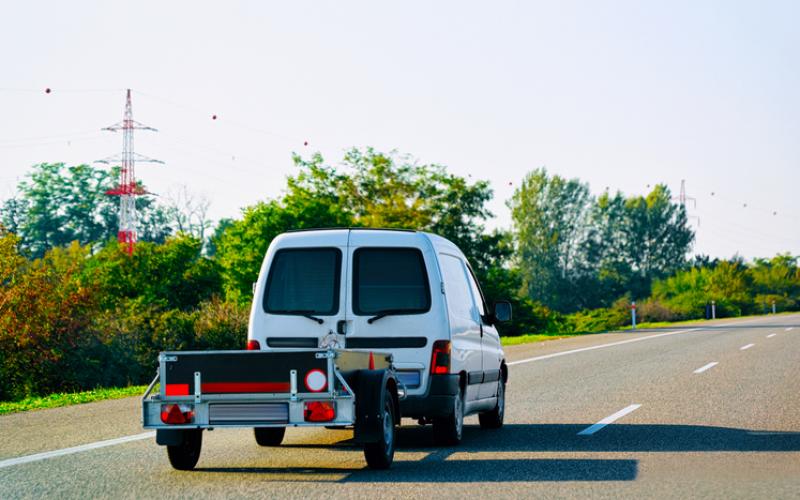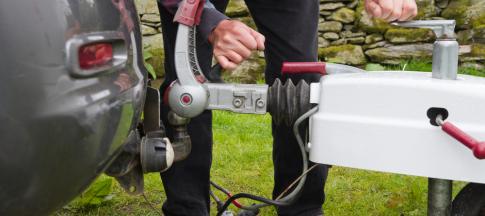
However, there are many pitfalls for the unwary, from both practical and legal perspectives. Read on for what van drivers need to know when it comes to towing.
Your driving licence
The weight of van and trailer you’re allowed to drive depends on when you passed your driving test.
If it was on or after 1 January 1997, you can drive a van or pick-up rated up to 3,500kg Gross Vehicle Weight (GVW) – also known as gross vehicle mass (GVM) or maximum authorised mass (MAM) – and tow a trailer of up to 750kg GVW. The GVW is the total permissible weight of the van or trailer, with a load, driver and passengers etc.
In addition, you can tow a trailer above 750kg GVW, providing the total GVW of the van and trailer combined doesn’t exceed 3,500kg.
For anything heavier, you’ll need to take the trailer driving test to gain a Category E on your driving licence. This will allow you to drive a combined weight of up to 8,250kg GVW.
If you passed your car test before 1 January 1997, you’re usually allowed to drive a vehicle and trailer combination up to 8,250kg GVW.
Maximum weight
You’ve checked the manual and your van has a towing capacity of 3,500kg. Your trailer has a matching maximum GVW so you happily load it up to the hilt, knowing you’re legal. You also know your van has a maximum payload of 1,500kg, so you can put plenty in there too.
Actually, you can’t. Your van also has a maximum gross train weight (GTW), or gross train mass (GTM), indicated on the chassis plate. This is the limit that the combination of van, trailer and payloads can weigh.
If your GTW is 5,850kg and your laden trailer weighs 3,500kg, that just leaves 2,350kg for the van. The van, unladen weighs 2,000kg so that leaves just 350kg of capacity in the back.
It’s an easy mistake to make and a crucial factor not to overlook.
Tachographs
Tachographs record information about driving time, speed and distance. Often overlooked but a vital consideration for van and pick-up drivers using the vehicle with a trailer for commercial purposes, using a tachograph is required in most situations.
If the total permitted GVW of the trailer and van combined is over 3,500kg (even if it actually weighs under that with the load you’re carrying) a ‘tacho’ is required.
Even just fitting a towbar can be enough to mean a tachograph is required, as technically the vehicle may now be capable of operating at over 3,500kg GVW.
GOV.UK highlights some exceptions, such as when carrying “materials, equipment or machinery for the driver’s use in the course of their work” or “when driving the vehicle is not the driver’s main activity”. There’s also an exemption for carrying “live animals from farms to local markets and slaughterhouses”.
If operating under certain conditions within a radius of 62 miles from the driver’s base a tacho may not be required.
Speed limits
Regardless of any other restrictions, a van towing a trailer is limited to a maximum of 60mph, or lower where the speed limit dictates.
Limits around size and length
Conventional vans and pickups with a GVW of up to 3,500kg are permitted to tow trailers up to 7m long and 2.55m wide. If you need bigger, then you’ll need a heavier van and the appropriate licence. You can go up to 3m high without needing a notice in the cab warning of the overall vehicle height.
Overhangs from the rear are permitted, but as a rule this shouldn’t exceed 3m. Go over 2m and you’ll need a marker board, which must be illuminated at night. You’ll also need to be careful when turning as the overhang will swing out, potentially into oncoming traffic.
Brakes
This is a fairly simple rule – your trailer needs to have its own braking system if it’s over 750kg GVW.
Safety first
There’s no specific legislation relating to trailer maintenance, or any sort of mandatory testing such as an annual MOT. While it’s rumoured that compulsory registration and testing may happen in the future, it’s currently the driver’s responsibility to make sure the trailer is roadworthy and complies with general legislation in areas such as lighting and tyres, etc.
Periodically, a garage or competent DIY mechanic should do the following:
- Check all lights work
- Check wheel nuts for tightness
- Make sure tyres are in good condition and pressures are correct
- Grease and adjust wheel bearings
- Check brake shoes for wear and remove dust. Adjust if necessary
- Inspect the coupling, check for correct operation and grease
- Inspect chassis and all components for wear, damage and security
Driving tips
If you’ve never driven a vehicle with a trailer it can be quite a daunting prospect. Vans often have a restricted view to the rear, making the task seem almost impossible – especially manoeuvring or reversing. So what should you do?
- Practice: Remember when you were learning to drive? You probably used an empty car park or some waste land to gain some initial confidence. Doing this again with a trailer in tow will let you practise the very basics, and allow you to experiment with little danger of causing any damage.
- Stopping distance: Even though your trailer is probably braked, the extra weight means it’s going to take longer to stop than you’re used to.
- Take wider turns: You’ll probably learn the hard way here and your trailer may well find itself mounting the kerb at some point. Your vehicle is much longer now so you’ll need to pull out further and turn in later to avoid mishap.
- Reversing: The key to getting this right is practice. Turning the steering wheel in the opposite direction to that you’re familiar with to persuade the trailer to go in the intended direction takes a lot of getting used to. There’s no short cut, literally.
- Trailer sway: Modern vans are starting to incorporate technology to prevent the frightening tendency for a trailer to start ‘wagging’ when driving – in extreme circumstances, this can cause the trailer and the towing vehicle to overturn. Although theories of how to deal with this differ (some suggest accelerating, others slowing gently) all agree that braking is the worst possible thing to do.
I started my career selling vans in the mid-eighties, progressing through dealer groups to management level. In 2010 I joined vehicle valuation company CAP, being made responsible for forecasting future used values for all makes and models of vans and trucks, this data being used by leasing companies and manufacturers to assess future risk. This role entailed very early exposure to new models including extensive testing across Europe.
In 2016 I started up my own consultancy business dedicated to the LCV industry. In addition, my freelance written work has been used by a number of clients and I am a regular contributor to WhatVan? magazine. I’m also a judge for their annual ‘Van of the Year’ awards.
To relax, I enjoy travel and walking near my Yorkshire home.



